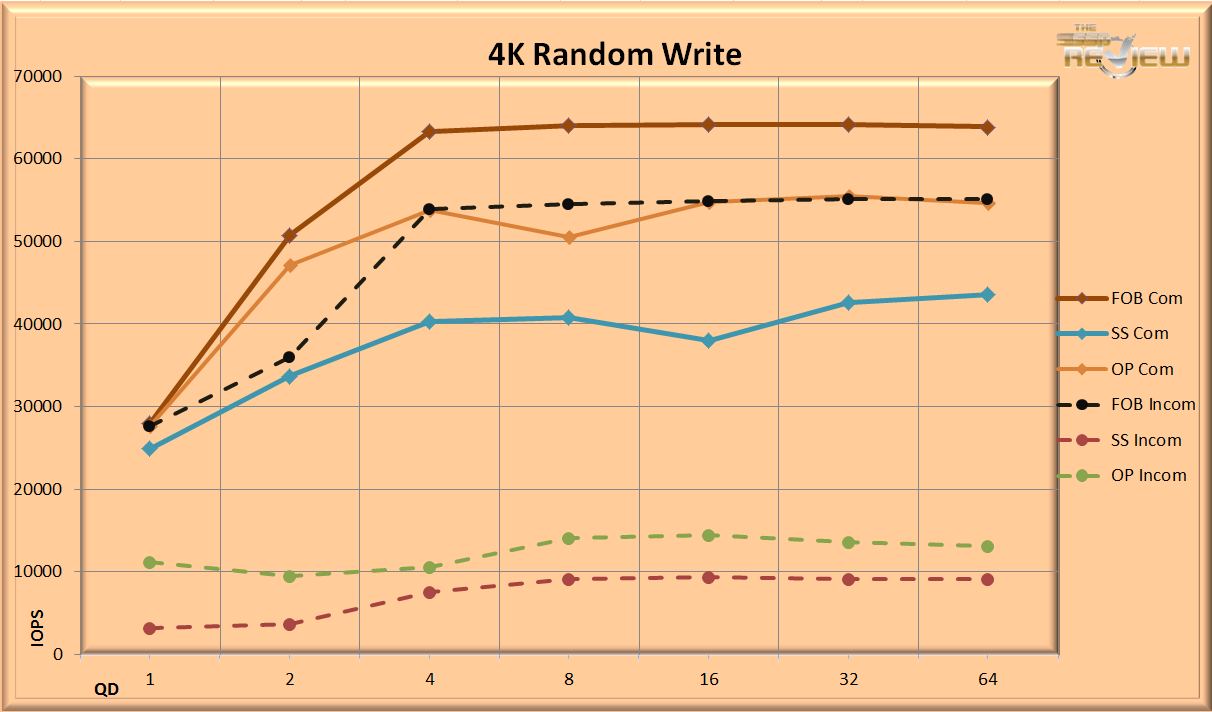RANDOM WRITE MEASUREMENTS
We begin delving into the difference between FOB (Fresh Out of Box), Steady State (SS), and 20% over provisioned (OP) execution for this battery of tests.
FOB testing consists of an 8GB LBA. The Steady State testing is conducted at 100% fill capacity, and utilizes full span writes. This is truly the torture test and gives an accurate picture of the SSD under the most demanding circumstances. Being a worst-case scenario, Steady State should be received as such. The 20% OP testing consists of 20% of the drive being left unformatted. The formatted region is filled to capacity, and written to full span. This provides results consistent with an optional performance boost for users.
We will also begin to compare compressible and incompressible data performance with the LSI SandForce SSDs. LSI SandForce SSDs rely upon compression for some of the performance advantages that they possess. The compressibility of the data of each workload can vary tremendously depending upon the type of data used, and here SandForce drives have a distinct advantage, as most enterprise data is very compressible.
It is extremely important for users to know their workload, and tune the SSD accordingly. We are testing with 100% compressible data, represented as solid lines. Full Random data, represented as the dashed lines, cannot be compressed. Data in some deployments will have varying levels of compressibility, so the performance may vary, and reside between these two values for semi-compressible data.
The random read write results are excellent with compressible data, coming in at 43,594 in steady state with compressible data, which is far higher than the rated 20,000 IOPS. With the 100% incompressible data the drive scores 9,138 IOPS at a QD of 32, and with a bit of extra overprovisioning can be increased to the 14,000 IOPS range.
 The 128K Random Write tests also come in very high with compressible data at 434.7MB/s at QD32 in steady state. The 100% incompressible speed resides much lower at 31.27MB/s and jumps up to 46.27 with overprovisioning at a QD of 32.
The 128K Random Write tests also come in very high with compressible data at 434.7MB/s at QD32 in steady state. The 100% incompressible speed resides much lower at 31.27MB/s and jumps up to 46.27 with overprovisioning at a QD of 32.
Power consumption is always a big deal in the server environment for several reasons. Providing power, and redundancy for that power, is a very expensive proposition and the highest ongoing expense for any enterprise application. Power consumption also equates to heat production, which in turn requires more power to effectively dissipate via active cooling solutions.
Two key measurements are most often mentioned when discussing the power requirements of any Storage device, that being idle and start-up power consumption. Idle highlights the theoretical minimum power draw, while start-up can represent the other end of that spectrum.
The SSD idles at 1.57 Watts, and consumes 3.22 Watts during start-up.
 The power testing allows us to observe the power consumption over a wide variety of our tests, with the random read workloads coming in with the highest values. These low power consumption values are excellent across the board, with the peak consumption being 5.43 Watts during 4k random read, and the lowest coming with 4k random write, at 4.08 Watts. These high-load values, taken at a QD of 32, are more representative of the loading that the drive will be placed under than the idle and start-up measurements.
The power testing allows us to observe the power consumption over a wide variety of our tests, with the random read workloads coming in with the highest values. These low power consumption values are excellent across the board, with the peak consumption being 5.43 Watts during 4k random read, and the lowest coming with 4k random write, at 4.08 Watts. These high-load values, taken at a QD of 32, are more representative of the loading that the drive will be placed under than the idle and start-up measurements.
With the power consumption being very low, look for this drive to dominate on the IOPS/Watts chart on the next page!
 Finally for the power and heat category we will compare the heat output across a wide gamut of testing scenarios. We measure the temperature by placing a digital thermometer in the center of the SSD, and another to measure the ambient air temperature. The values are represented as a T-Delta to ambient, to account for any slight variations in ambient temperature over the course of the test. Both sensors are calibrated to mirror each other.
Finally for the power and heat category we will compare the heat output across a wide gamut of testing scenarios. We measure the temperature by placing a digital thermometer in the center of the SSD, and another to measure the ambient air temperature. The values are represented as a T-Delta to ambient, to account for any slight variations in ambient temperature over the course of the test. Both sensors are calibrated to mirror each other.
The low power consumption of the SSD under load pays big dividends here, as the overall temperature generation is impressively low. This low heat generation is very important as it will not disturb the server environment, or create a need for excess active cooling. These are among the lowest heat generation numbers that we have observed in testing many devices.
 The SSD Review The Worlds Dedicated SSD Education and Review Resource |
The SSD Review The Worlds Dedicated SSD Education and Review Resource | 